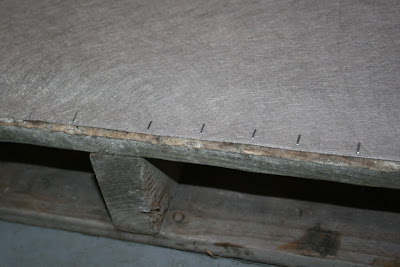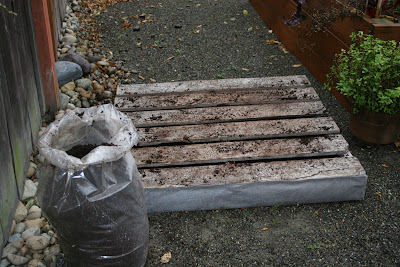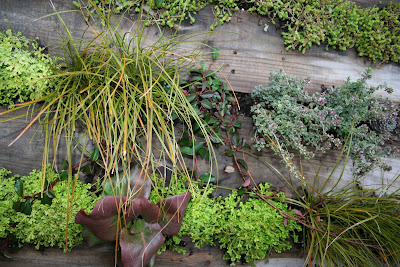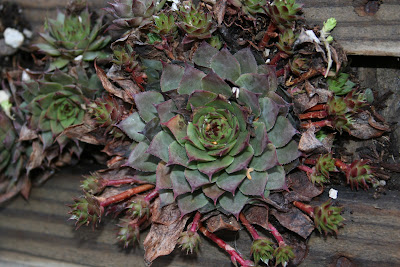A few months back I stumbled across this awesome idea to turn a shipping pallet into a vertical planter on Fern Richardson's blog. Is Fern not the best name for a gardener? I'm secretly jealous.
A few weeks ago I took the time to make one myself, and I'm super excited about how it turned out!
 |
| . |
I LOVE the beauty and feel of living walls, and of course I'm all about reclaiming waste materials and turning them into something truly special, so this was definitely the project for me.
Below is a tutorial on how I made this vertical planter, but again I got my directions from Fern:
Materials:
1 shipping pallet, no longer in use
36-50 plants in 2" or 4" pots, depending on the size of your pallet
landscaping fabric
staple gun
potting soil + compost
1. Find a pallet that won't be used again
Most pallets get used over and over again, but those that are broken or damaged cannot be used for carrying heavy things with a forklift anymore. These are the ones you want to get. I got a broken pallet while I was picking up some compost at Sawdust Supply, but I sometimes see them in parking lots behind big stores like Best Buy and Costco. I'd ask before taking one... especially to make sure it's not still being used.
Fix your pallet if it needs it. Make sure there are no nails poking out that need to be hammered back in, big splinters that need sanding down, or loose boards that need to be secured.
2. Line your pallet to hold in the soil
Decide which side of your pallet will be the front, and which will be the top. The front should be the side with narrow slats (no more than 4 inches).
Line the back, sides, and bottom of your pallet with a double layer of landscaping fabric. Pull the fabric taut across the top edge of the pallet, without covering the opening at the top, and using a staple gun attach it to the pallet. Put staples in every 2 inches. Then continue down the sides and the bottom like you are wrapping a present. Remember to make everything neat and tidy so it will look nice.
 |
| Landscaping fabric stapled along the top edge of the planter. Notice that the opening is still free to plant in. |
 |
| Landscaping fabric stapled along the vertical sides of the planter. |
This was the hardest part of the whole project for me, but it really wasn't very hard at all.
Don't cover the top of the slats on the front of the pallet, as you will plant these areas.
3. Fill your pallet with potting soil
With your pallet lying on its back, fill it with potting soil and compost through the slats in the front. I like GroCo compost a lot, so I like to add it to all my potted plants along with a light potting mix, like Gardner and Bloome's planting mix. My pallet was 3.5' by 3.5', 6" deep, and I used about 3 cubic feet of soil all together. You really want to pack this stuff in tight!
 |
| Make sure the entire planter is filled with soil. It won't work if there are gaps between the rows, because all the soil will fall to the bottom when you turn it upright. |
4. Arrange your pots on top of your pallet
Do this to figure out the pattern in which you want to plant them. This part is sorta like painting. I tried to cluster types of plants, and went for a variety of contrasting textures. I moved things around a little bit until I was happy with how it looked.
 |
| I tried a few arrangements before I got the plants how I wanted them. Leaving them in their 4" pots made it easy to move them around |
5. Plant your pallet
Plant from the bottom up. Make sure that your plants are packed in there really tight! I found that I needed to add more soil as I planted because I kept on pushing soil down towards the bottom. You want the plants to be snug so that no soil or plants fall out when you turn the pallet upright.
Don't plant the very top yet!
6. Leave your pallet horizontal for a couple weeks
It will be hard to wait, but this will allow roots to establish and will keep soil and plants from falling out the front.
 |
| . |
 |
| . |
7. Turn your pallet upright
Yahoo! Now that your plants have had a couple weeks to establish, you can turn it vertical by leaning it up against a wall. At this time you should plant the very top of your pallet. I added a tall grass in the corner for a little verticality, and because I thought it looked fun. I also added more wintergreen because I love the way it looks trailing down across the lines of evenly spaced plants.
 |
| . |
 |
| . |
 |
| . |
 |
| . |
 |
| . |
8. Maintenance and Care
These types of planters tend to dry out quickly. Once our rainy season ends (will it ever end?) it will likely need to be watered every other day. I'll have to see how the soil moisture is doing. I'm hoping that the fact that I planted hardy drought-tolerant succulents, herbs, sedums, and grasses will serve me well through the summer.
Wouldn't it be neat to plant strawberries in one of these? I'm imagining a strawberry fence...
Thanks Fern for the inspiration!
p.s. Looks like the ladies at design*sponge were also inspired by this project.




0 comments:
Post a Comment